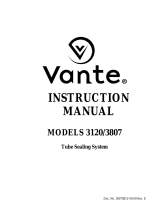Tyco Electronics A1037-A User manual
- Category
- GPS receiver modules
- Type
- User manual
Tyco Electronics A1037-A is a highly integrated GPS receiver module that can be used as an SMT component. It is capable to receive signals from up to 12 GPS satellites and transferring them into position and timing information that can be read over a serial port. This new generation of GPS module combines small size and high-end GPS functionality at low power consumption. With dimensions of 19 x 16.2 mm (0.75” x 0.64”) and weighing only a few grams, it is suitable for space-constrained applications.
Tyco Electronics A1037-A is a highly integrated GPS receiver module that can be used as an SMT component. It is capable to receive signals from up to 12 GPS satellites and transferring them into position and timing information that can be read over a serial port. This new generation of GPS module combines small size and high-end GPS functionality at low power consumption. With dimensions of 19 x 16.2 mm (0.75” x 0.64”) and weighing only a few grams, it is suitable for space-constrained applications.




















-
 1
1
-
 2
2
-
 3
3
-
 4
4
-
 5
5
-
 6
6
-
 7
7
-
 8
8
-
 9
9
-
 10
10
-
 11
11
-
 12
12
-
 13
13
-
 14
14
-
 15
15
-
 16
16
-
 17
17
-
 18
18
-
 19
19
-
 20
20
-
 21
21
-
 22
22
-
 23
23
-
 24
24
-
 25
25
-
 26
26
-
 27
27
-
 28
28
-
 29
29
Tyco Electronics A1037-A User manual
- Category
- GPS receiver modules
- Type
- User manual
Tyco Electronics A1037-A is a highly integrated GPS receiver module that can be used as an SMT component. It is capable to receive signals from up to 12 GPS satellites and transferring them into position and timing information that can be read over a serial port. This new generation of GPS module combines small size and high-end GPS functionality at low power consumption. With dimensions of 19 x 16.2 mm (0.75” x 0.64”) and weighing only a few grams, it is suitable for space-constrained applications.
Ask a question and I''ll find the answer in the document
Finding information in a document is now easier with AI
Related papers
Other documents
-
Maestro A1084 User manual
-
Maestro A2100-A/B User manual
-
Lantronix A2235-H User guide
-
Crathco / Grindmaster 7444E Operating instructions
-
American Metal Ware 8106E Operating instructions
-
Lantronix A5100-A User guide
-
 Vante 3120/3807 Tube Sealing System User manual
Vante 3120/3807 Tube Sealing System User manual
-
Lantronix A2200-A User guide
-
Maestro A2100-B User manual
-
Maestro A2200-A User manual


































